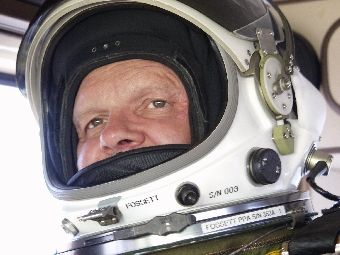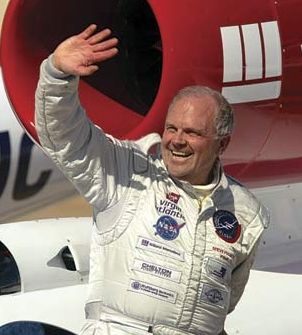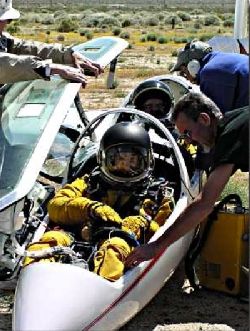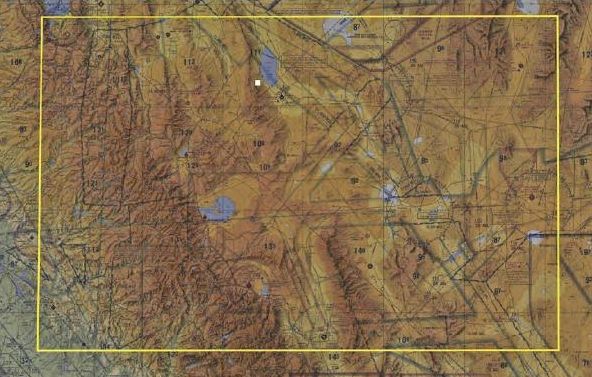
Publisher:
Bonnie King
CONTACT:
Newsroom@Salem-news.com
Advertising:
Adsales@Salem-news.com

~Truth~
~Justice~
~Peace~
TJP
Nov-29-2007 16:32

 TweetFollow @OregonNews
TweetFollow @OregonNews
Civil Air Patrol Launches Massive Hunt for World Famous Aviator
By Steve Cox/Civil Air PatrolThe search for the wealthy adventurer Steve Fossett is officially on hold, for now.
 Legendary aviator Steve Fossett Photo courtesy: stevefossett.com |
(RENO, Nevada) - The Civil Air Patrol’s hunt for famed, record-setting aviator Steve Fossett, who vanished on Labor Day during a morning jaunt in Nevada, is the largest and perhaps most expensive in modern-day history.
Encompassing a 22,000-square-mile area in the heart of the nation’s most treacherous region and involving Civil Air Patrol pilots from Nevada and seven other states, the Nevada National Guard, the Air Force Rescue Coordination Center, the U.S. Army, the state Departments of Emergency Management and Public Safety and ground crews organized by local authorities, the search for the wealthy adventurer is officially on hold, for now.
“The Civil Air Patrol joins the rest of the aviation world and admirers worldwide in its disappointment in not locating Steve Fossett,” said CAP’s Interim National Commander Brig. Gen. Amy S. Courter in announcing the search’s suspension on Sept. 16. The decision followed intensive, technology-enhanced aerial searches from CAP’s Cessnas and Gippsland GA8 Airvans, the Air Guard’s C-130s and the Army’s Black Hawks.
“This remarkable man showed us what grit and determination are all about. In his life, he chased and shattered world records, floating and flying farther and faster than anyone before,” Courter said. “His adventures are many and his accomplishments profound. We regret those adventures may have come to an end.”
Fossett, 63, took off September 3rd for a solo flight from the Flying M Ranch, a posh aviation playground about 70 miles southeast of Reno owned by his friend, hotel mogul Barron Hilton. Fossett didn’t file a flight plan for the three-hour trip, and he never returned to the ranch.
The search centered in Nevada: Initially, more than 60 Nevada Wing
members and six aircraft were involved in the search effort. This
expanded to include more than 100 CAP volunteers and 25 aircraft
over the course of the search.
The aerobatic plane is equipped with an older-model emergency locator transmitter, or ELT, but it apparently never activated. Fossett also didn’t wear a wristwatch he owned that would have allowed him to signal his location in an emergency.
Since Fossett’s disappearance, the National Transportation Safety Board, which investigates aviation accidents, has recommended that planes be equipped with more reliable digital transmitters.
 Steve Fossett Courtesy: cache.eb.com |
The Air Force credited CAP with saving 105 lives in fiscal year 2007. The Civil Air Patrol-led effort in the search for Fossett was extraordinary.
At its peak, the search involved more than 45 aircraft, many of them from the Civil Air Patrol’s fleet. CAP’s pilots flew 629 flights totaling 1,774 flying hours. In all, more than 17,000 man-hours were invested in the mission, both in the air and on the ground.
“Although the search effort by the Civil Air Patrol has been officially suspended by the Air Force Rescue Coordination Center, should new information become available, CAP could be asked to assist once again with its considerable air assets,” Courter said. “We are now waiting for new leads, and as they develop we will check them out.”
Presumed dead
Those involved in the hunt for Fossett said they are not giving up, even though the National Transportation Safety Board, in its preliminary report about Fossett’s disappearance, listed the presumed accident as a fatality.
Early in the search, Hilton hired a private aircraft company with imaging equipment to assist ground searchers. Some of those private efforts financed by Fossett’s friends and family continue. Fossett, who made millions as a commodities broker in Chicago, had survived many scrapes en route to setting 116 flying and sailing world records and accomplishing other feats. He also scaled some of the world's best-known peaks, including the Matterhorn in Switzerland, swam the English Channel and even completed the Iditarod sled-dog race in Alaska.
In 2002, he became the first person to fly a balloon solo around the globe. Three years later, he became the first to fly an airplane alone nonstop around the world.
 “My gut feeling is that he didn't survive the impact,” said Maj. Cynthia S. Ryan, public information officer for the Nevada Civil Air Patrol. She said if Fossett were alive but too injured to walk, he would have tried to signal searchers in some manner.
“My gut feeling is that he didn't survive the impact,” said Maj. Cynthia S. Ryan, public information officer for the Nevada Civil Air Patrol. She said if Fossett were alive but too injured to walk, he would have tried to signal searchers in some manner.
“He’s not the kind of guy to just sit and wait for help to show up,” she said. Many involved in the Nevada search, including Ryan, believe Fossett’s small plane plummeted into one of the countless craggy, deep ravines that cut the state’s landscape like claw marks, causing the wreckage to become scattered or highly fragmented and simply invisible to searchers.
“It’s definitely an area where a person can get lost and not be found, as witnessed by this search,” said Capt. Bill Schroeder, a master-certified flight instructor and check pilot examiner for the Nevada Wing.
“A lot of it comes down to what is in view and possible,” said Lt. Col. John W. Desmarais Jr., deputy director of operations at CAP National Headquarters. “If (Steve Fossett) crashed in an area where the wreckage is obscured from view or the wreckage blends into the background, it will be difficult, at best, to locate.”
“This is a testament to the unforgiving terrain comprising the search area,” said Lt. Col. E.J. Smith, the Nevada Wing search leader who served as the primary incident commander for 17 days of the mission. “We’ve executed this to the very best of our trained ability and have come up with nothing.” How the search unfolded “Since Mr. Fossett did not file a flight plan, CAP defined an area of possibility for the search for his airplane based on the amount of fuel on board, and wind and weather conditions at the time of the flight,” said Col. Dion DeCamp, CAP’s Nevada Wing commander. “That created a huge area,” he said, “so we focused on those areas that made the most sense — like radar tracks, which were analyzed for aircraft matching the Fossett aircraft’s profile.
There were several, and those areas were searched repeatedly.” Hikers who thought they saw Fossett’s plane gave CAP additional leads in the early stages of the search, as did information gleaned from interviews with friends and people who had been with Fossett at the Flying M Ranch. “Those leads have been thoroughly searched as well,” said DeCamp, as CAP initially scaled back the search on September 16th. “The search areas were plotted on a map and thoroughly documented, including weather conditions at the time of flight.
“Additional attention was focused on radar drop-off points,” he said, “which could mean a crash or, in mountainous terrain, simply that the radar could not see the aircraft because it was operating at low altitude and was blocked by the mountains.”
CAP renewed the search on the weekend of September 29th-30th, concentrating on “high probability sites” identified by a dozen Federal Aviation Administration, Air Force, Navy, NTSB and CAP experts. From the start of the weekend operation, aircrews end up with is extreme turbulence and strong downdrafts on the eastern side of the mountains.”
The aircrews performed valiantly despite the adverse conditions, according to Schroeder. “During the search we had some ridgetop winds that were exceeding 80 mph,” he said. “The winds prohibited searching on those days as it was too turbulent to fly.”
On most days, each crew flew two three-hour sorties a day. In the end, they were tired, he said, adding that he pccasionally took a break from flying and worked on the ground. “I did everything from weather reports to taking in information from others who thought they might know where Steve Fossett was,” said Schroeder. “We had people calling in from all over the world.”
High-tech help
The Civil Air Patrol called in aircraft from California and Utah equipped with cutting-edge ARCHER (Airborne Real-Time Cueing Hyperspectral Enhanced Reconnaissance) technology. ARCHER gives aircrews the ability to find unique objects on the ground, like parts of a plane, using specially equipped on-board computers and hyperspectral sensor technology capable of seeing much more detail than the human eye.
 This map captures approximately one-third of the Steve Fossett search area. The tiny white square in the |
“To find five targets, we looked at over 30,000 images,” Seneviratne said. Those five targets included old crash sites, some dating from the 1960s and 1970s. Nevada law enforcement officials plan to inspect the wreckage sites more closely. Internet users also participated, volunteering to peer at newly released satellite images of the area. The amateur army of online searchers were welcome, even though mission bases were inundated with Google-generated “finds” that turned out to be junked cars or abandoned appliances.
“They didn’t know what they were looking for,” said Ryan of the virtual search effort, which quickly dwindled to just an occasional lead for searchers to check out. “The Google searches are not quite ready for prime time,” she said. Other non-tech leads, some of them a little strange, also were submitted, according to Desmarais. “We have received tons of inputs from a variety of sources. Some are credible; some just aren’t.
Story continues below
Psychics, dreamers and all sorts of variations of those have come forward.” The cost of the private search by Fossett’s friends has not been disclosed, but Gary Derks, operations director for the Nevada Office of Emergency Management, said costs to various government agencies involved in the hunt total nearly $1.4 million. “It’s in the range of $250,000, just for CAP,” said Ryan.
“But when you consider the hours and the effort, that’s a huge bargain.”
Now it’s up to chance
Despite all the technology and manpower used in the Fossett search, the person who finds the missing aviator quite possibly won’t even be looking for him. With hunting season opening or about to open within the search zone, hunters may provide the next clues. Another possibility is prospectors, who have many small mines in the wastelands of the search zone.
In the meantime, winter is coming on, and snow is already falling in the higher elevations of Nevada and California. That doesn’t leave much time for searching for Fossett or his plane. A big storm could blanket the wreckage, making it undetectable until spring.
Ryan is convinced the wreckage will be discovered one day, by a hunter, a prospector or perhaps a hiker. “It will probably be found in the next two or three years,” she said. “It will be found eventually.”
The Associated Press, ABC News, the San Francisco Chronicle, the New York Times and General Aviation News contributed to this report.
Articles for November 28, 2007 | Articles for November 29, 2007 | Articles for November 30, 2007




googlec507860f6901db00.html

Terms of Service | Privacy Policy
All comments and messages are approved by people and self promotional links or unacceptable comments are denied.
[Return to Top]
©2025 Salem-News.com. All opinions expressed in this article are those of the author and do not necessarily reflect those of Salem-News.com.